Buying an expensive e-gravel bike, but then choosing to ride it with the motor turned off sounds like madness doesn’t it? A typical e-gravel bike is likely to be double the weight of an ‘acoustic’ one, so unless you’re some kind of masochist, why would you even consider riding it without the extra assistance of the battery and the motor? Always on the lookout for some extra training (and a good story?), Olly decided to head out on the new Canyon Grizl:ON e-gravel bike, but ride it using leg power alone.

Hanover Street in Newcastle has a gradient of 9% and is just shy of 300m long. It dates from 1841 and is cobbled, but with large granite ‘baulks’ laid into the surface to form tramways to allow horse-drawn wagons to be pulled up it more easily. The smaller stones are called setts and are also formed from granite. The granite cobbles have settled over time, so the surface is rippled. In places, poor-quality repairs have been made using patches of tarmac. I use it pretty regularly when I’m on my bike and am travelling up from the River Tyne back into the centre of the city. It tends to be at the end of a ride, it’s by no means an easy climb and my legs are normally shot, but there’s something appealing about doing “just one last challenge” before heading home.
“Oooooof. That’s going to be pretty boggy”
The last time I rode up Hanover Street I ‘only’ had 73 km in my legs. The problem with just seeing a figure on your computer screen and assuming that gives you great insight into how tired you should be, is of course that the distance travelled (and the amount of effort it has taken) depends entirely on the route you have chosen. This particular day, I’d done my best to plot a route that would be fun, challenging, interesting and involving. We’d done a whole bunch of trails that we hadn’t ridden for ages. We’d shoehorned in some new trails, rediscovered some scraps of woodland singletrack that we hadn’t ridden for years and had even tested out a new café stop. But I’d also included the section in the photo above. “Oooooof. That’s going to be pretty boggy” said Francis, as we turned onto the start of the trail. “When did you last ride it?” he queried. When Francis leads a ride, he is incredibly diligent and will often pre-ride it a few days before and then tweak the route, depending on what he finds. I, on the other hand, had relied on a combination of trail-memory, satellite images, Google Street View and potluck when putting our route together.

"I wanted to test how the bike rode without the motor assistance"
Taking a 'box-fresh' Canyon Grizl:ON out on its first ride after a winter of record-breaking rainfall might seem a little foolhardy. Deciding to do as much of the ride as possible with the motor turned off was therefore an even more questionable decision, but there was some logic to my madness. Canyon reckoned that the in-built battery gave around 60 km of powered assistance to the rider, which would be plenty enough for many people, but I knew that our typical Friday Gravel Gang rides were more like 100 km or longer. It meant that in all likelihood the battery would run out before I got home, so I wanted to test how the bike rode without the motor assistance. What better way to try it than to do as much of the ride as possible with the motor turned off, but then have the ability to switch it on at the end of the ride if my legs were cooked and I needed a bit of a helping hand on the final climbs?

During the first hour of riding, the unpowered Grizl:ON rode fantastically. The tyres weren’t quite as grippy as the ones I typically used, but that wasn’t surprising as they were a more generalist pattern, designed for bike paths, trips to the shops and broken tarmac, more than the greasy, root-infested trails that we had chosen to ride. I’d set them up tubeless and ran the pressure as low as I dared and after a few initial slides, I soon got used to the lower levels of traction. The bike handled with aplomb everything I asked of it. My riding buddies had done some collective eye-rolls when I told them of my idea to ride it in acoustic mode, but very quickly after setting off I forgot about the extra heft and started to really enjoy the ride.
"The entire trail was under hub-depth water, with no option to go around the edge."
We knew that the section of trail in the video would be wet, but this exceeded anything we had seen before – the entire trail was under hub-depth water, with no option to go around the edge. Despite feeling extremely guilty about subjecting the Grizl:ON to such a literal watery baptism, I didn’t really have any choice. I pushed the power button, watched the lights come on, selected high power and set off through the water. Fortunately, the depth never got much above the hubs, but it did mean the motor was completely underwater for around 30 seconds. The engineers at Canyon had obviously built the bike for European conditions rather than Californian conditions, as everything worked smoothly and the bike continued to function ok. If I’m honest, I was a little underwhelmed with the power that the motor had given me, but I didn’t think anything more of it. I turned the motor back off and continued on with the ride, amazed at how well the bike rode and having a great time.
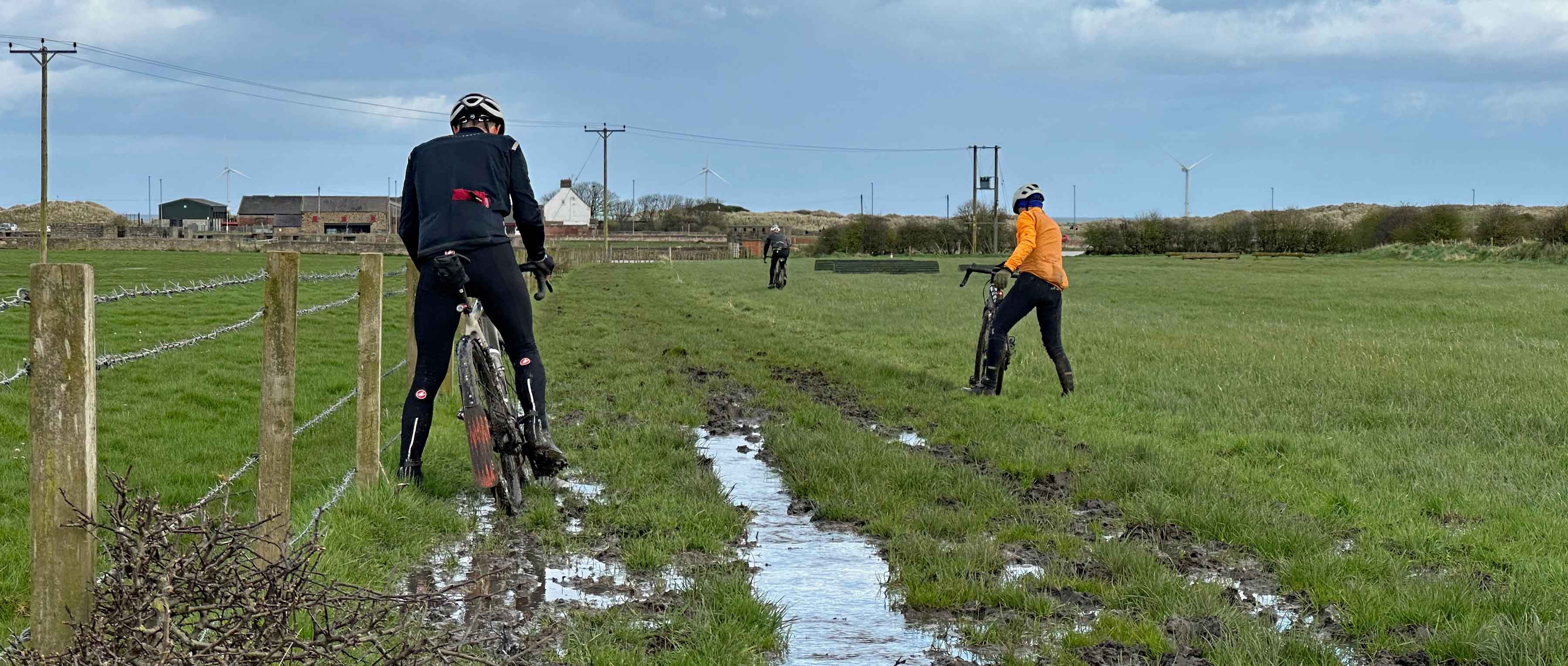
"The battery assistance might be just what he needed to get past the mid-afternoon low spot."
As anyone who has ever done long day rides before knows, the section after a café stop is always hard. You’ve cooled down a bit. Your stomach is full and your body demands time to digest, rather than being able to suddenly generate enough oomph to power you across a sodden bridleway. On the next section after the boggy field, a gravel bike path running down the coast, the hardpacked surface helped boost our pretty dismal average speed slightly. As we turned onto the next section of trail, which had numerous short, sharp climbs and descents, I realised that Graham was dropping further and further back. Everyone rides at their own pace and it’s perfectly normal to spread out a little, but he’s generally right at the front, so it seemed odd that he was struggling. I slowed down to make sure he was ok and offered him a muesli bar, figuring that his energy levels might be in a post-lunch-lull, particularly after the tough boggy sections. Then, I had a spark of inspiration – I could lend him the Grizl:ON. The battery assistance might be just what he needed to get past the mid-afternoon low spot.
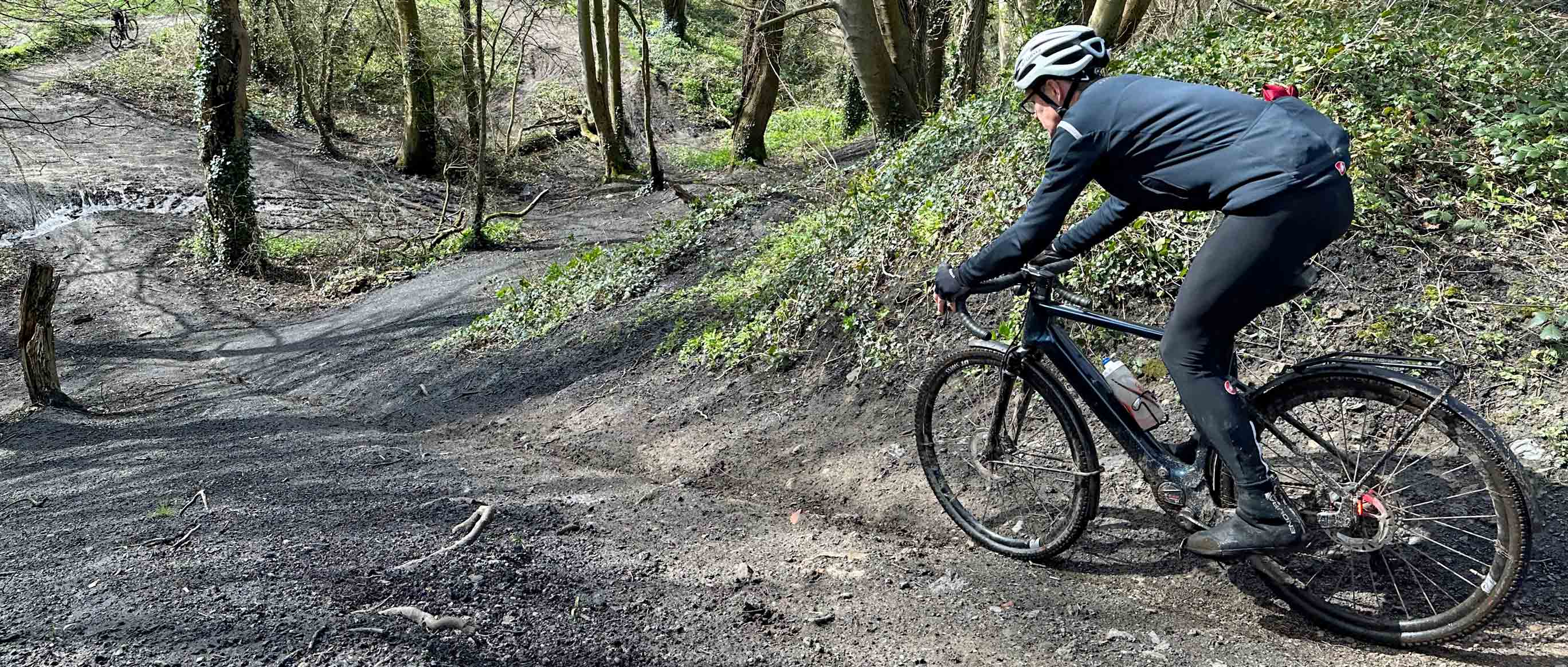
We swapped bikes and set off again. With my bike suddenly being half the weight of the one I was riding previously, I flew up the trail, assuming that Graham would be right on my wheel. When I looked around again shortly afterwards, I realised that he was quite a way behind again, so I slowed down in order that we could ride together. I was a little surprised that he wasn’t riding more rapidly. The motor would power him up to 25 kmh (15.5 mph), the maximum that the law in the UK allows, and we were riding less than that, so he should have been able to easily keep up. I figured he must have been having a bad day, but didn’t think much more about it and we continued on with the route.
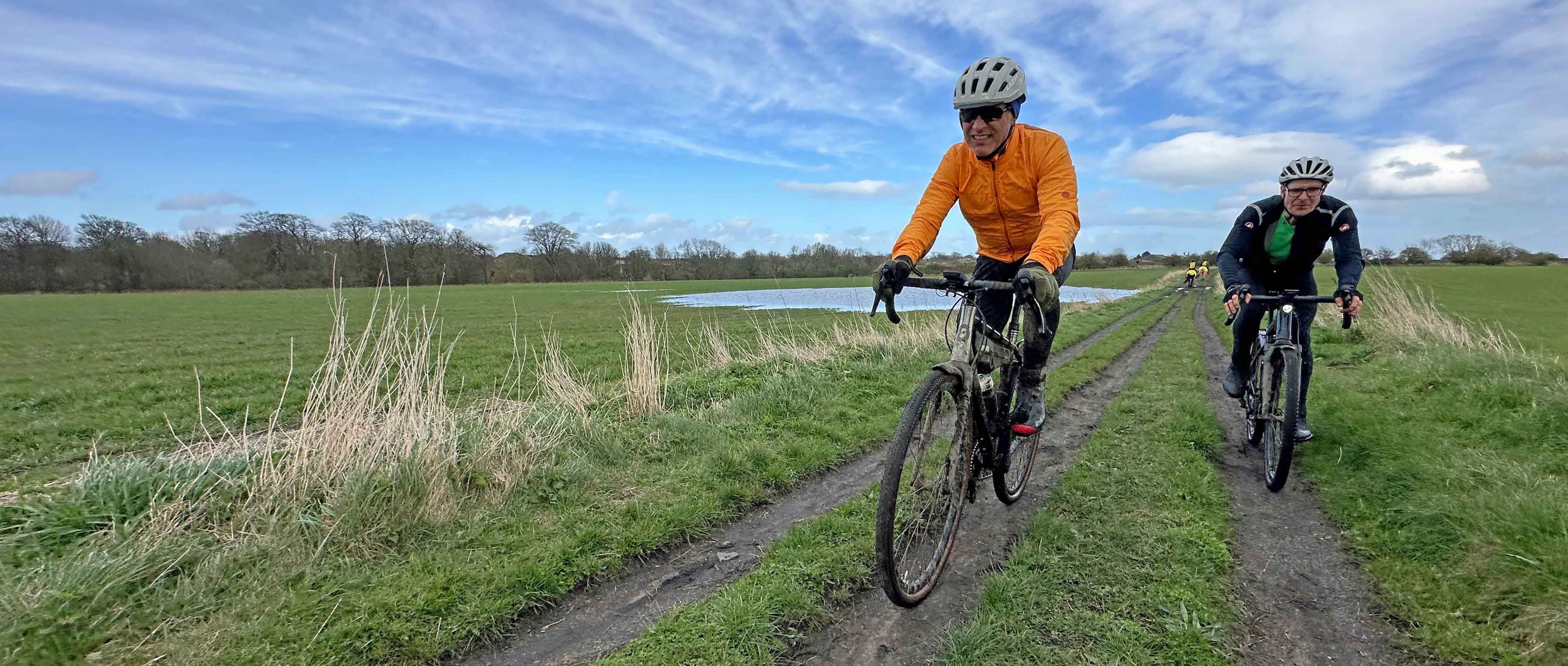
The next part of our route initially wove a sinuous and challenging path through a stretch of woodland before popping out onto a series of pan-flat gravel tracks, formerly the course of a series of small railways which historically took freshly mined coal down to the coast for export, but were now converted into gravel riding heaven. After thirty minutes or so of more gentle terrain, Graham rode alongside me and suggested we switch bikes again. Initially, it was quite a shock getting back on a 15kg+ bike again, but I was determined to try and finish the ride using as much of my own power as I could, so I turned the motor off and set off in acoustic mode. We had quite a tight timescale to meet, so we upped the pace and did a gravelly version of a team time trial for a while, taking it in turns to sit on the front into the headwind, helping to shelter the riders behind, all the while keeping an eye on the clock. Using some cunning shortcuts, we managed to shave a little distance and time off my planned route and we were soon back on the riverside in Newcastle, where we went our separate ways.
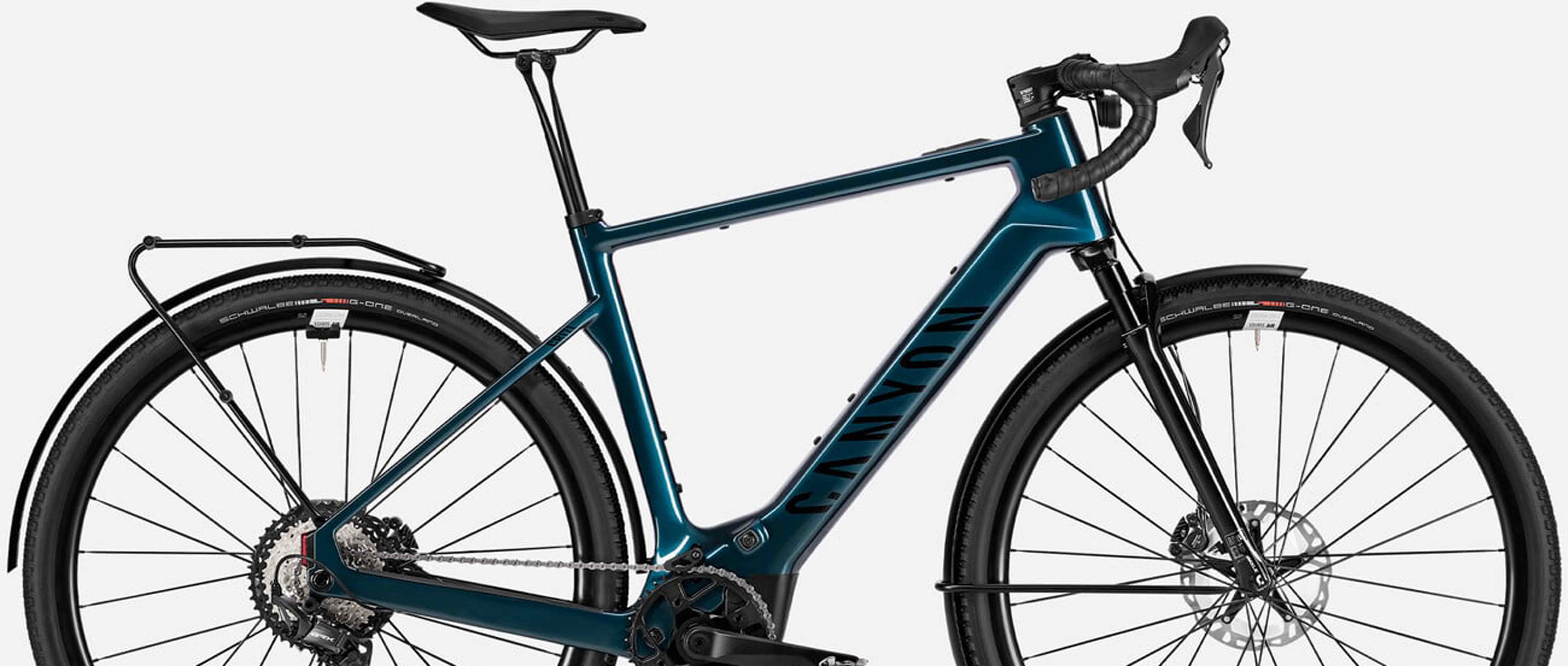
Image courtesy of Canyon Bikes
"I expected to be propelled up the cobbled climb like a seasoned pro taking on the cobbled ‘bergs’ of the Tour of Flanders"
As was typical for me, I decided to head home via Hanover Street, but I figured that having ridden in acoustic mode for the majority of the ride, that I should try out the motor properly and get some assistance for the final section back home, which was nearly all uphill. I turned the motor on and selected Sprint mode, slightly less than the maximum Turbo, as I still wanted to feel like I was using my legs. I set off, expecting to be propelled up the cobbled climb like a seasoned pro taking on the cobbled ‘bergs’ of the Tour of Flanders, but didn’t really make much progress. For the first few pedal strokes, you could sense the motor kick, but it seemed to rapidly fade and left me feeling quite underwhelmed. I figured that I could make it up the climb under my own steam, but was a little surprised. I knew that the design ethos behind the bike was to make it gravel-appropriate – less overall power to give the rider gentle assistance over longer distances, with smooth delivery to compensate for the lower levels of grip of a typical gravel bike tyre, but I was surprised that there wasn’t more oomph available.
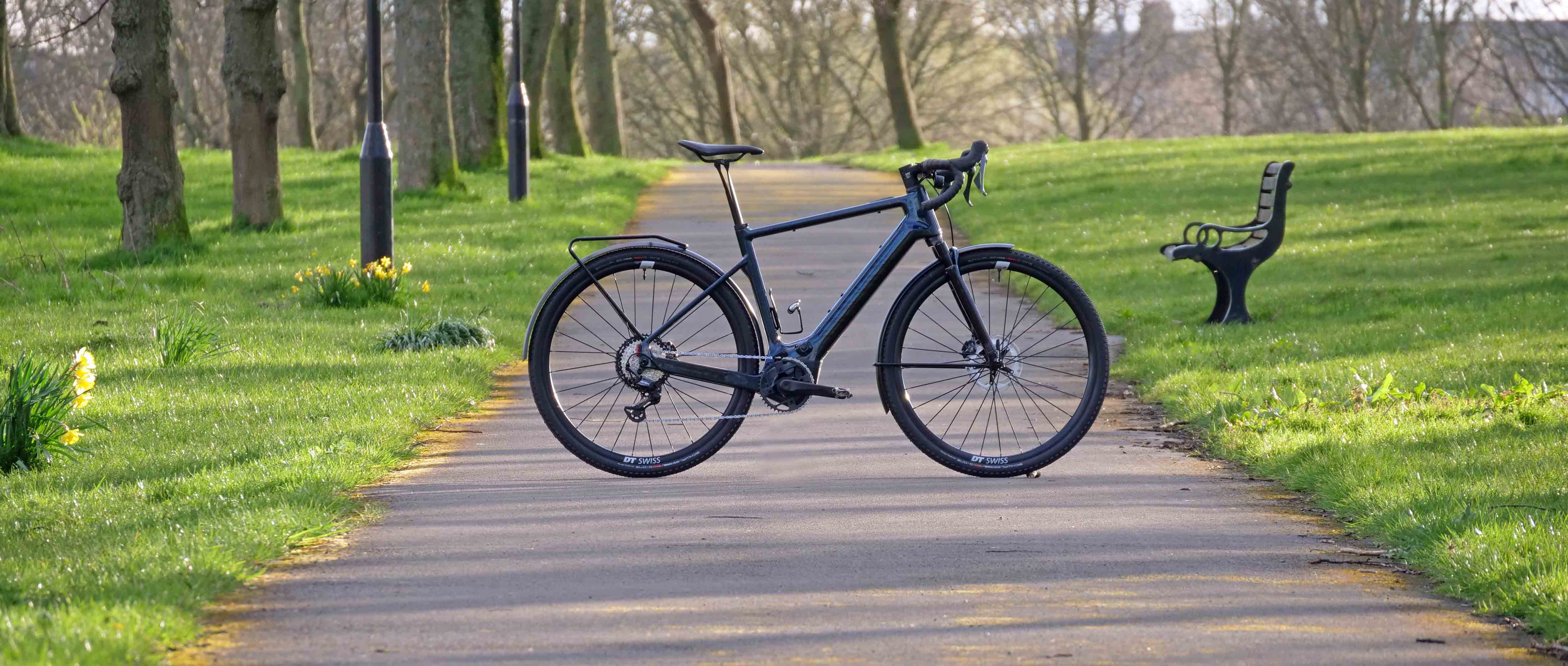
"I did a very large mental face-palm as I realised the schoolboy error that I had made."
At the top of the climb, I pulled over, got my smartphone out and connected to the Bosch Flow App. I’d used this when I first set the bike up to complete the registration, update the firmware and get some understanding of the different power modes available. As I connected the app, I noticed a pop-up message at the top which I hadn’t seen before - “Speed Sensor not registering”. At this point, I did a very large mental face-palm as I realised the schoolboy error that I had made. When the bike was delivered, it came set up with tubes and the inner tube in the rear wheel had a significantly longer valve stem than the one fitted to the front wheel. Fitted to the valve stem on the rear wheel was a small black plastic box. It was quite strange looking, was pretty ugly and I hadn’t seen one before, so I didn’t recognise it. When I set the tyres up tubeless, I fitted new valves, added sealant, pumped up the tyres and thought the bike was ready to roll. I left the little black box sitting on the bench. I’d done a few short test rides close to my home to check everything worked ok, tried out the different power modes and was happy. The bike didn’t seem to generate a lot of motorised oomph, but I assumed this was all part of the subtle power delivery.

It was only when I saw the error message on the App that I realised my mistake. By failing to re-fit the little black box, which turned out to be the speed sensor magnet, the bike didn’t recognise what speed the rear wheel was rotating at and therefore the motor didn’t give more than a few pedal strokes worth of assistance. Feeling slightly foolish and with tired legs, a very guilty thought popped into my head – when I had offered Graham the Grizl:ON to help him through his mid-afternoon low patch, what I had actually done was to give him an 8 kg weight penalty – not exactly the helping hand I had hoped to give him!
Fortunately, rectifying the problem was simple. Even with standard-length tubeless valves fitted there was just enough space to slip the speed sensor over the top. A couple of rubber o-rings (to stop any rattling) later and the bike was as good as new.
"Next time I decide to go for an e-assisted gravel ride, the bike will definitely be Grizl:ON rather than Grizl:OFF."
It was a good lesson in paying attention to the details. Just because you don’t recognise something fitted to a new bike doesn’t mean you can just remove it, while expecting the bike to still function as the designer intended. With the speed sensor magnet fitted the motor works perfectly. Next time I decide to go for an e-assisted gravel ride, the bike will definitely be Grizl:ON rather than Grizl:OFF.